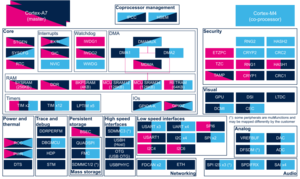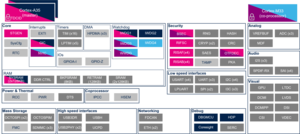Registered User mNo edit summary |
Registered User m (remove "Cortex-A35 master boot" chapters, useless for v6 and wording to review) Tag: 2017 source edit |
||
| (20 intermediate revisions by 5 users not shown) | |||
| Line 1: | Line 1: | ||
<noinclude>{{ApplicableFor | <noinclude> | ||
|MPUs list=STM32MP15x | {{ApplicableFor | ||
|MPUs checklist=STM32MP13x, STM32MP15x | |MPUs list=STM32MP15x, STM32MP21x, STM32MP23x, STM32MP25x | ||
}}</noinclude> | |MPUs checklist=STM32MP13x, STM32MP15x, STM32MP21x, STM32MP23x, STM32MP25x | ||
}} | |||
</noinclude> | |||
==Article purpose== | ==Article purpose== | ||
The purpose of this article is to | The purpose of this article is to: | ||
* briefly introduce | * briefly introduce the DCMI peripheral and its main features, | ||
* indicate the | * indicate the peripheral instances assignment at boot time and their assignment at runtime (including whether instances can be allocated to secure contexts), | ||
* list the software frameworks and drivers managing the peripheral, | |||
* explain | * explain how to configure the peripheral. | ||
==Peripheral overview== | ==Peripheral overview== | ||
The '''DCMI''' (digital camera memory interface) is | The '''DCMI''' (digital camera memory interface) peripheral is used to receive some video data from an external parallel camera sensor device or any other digital video equipment supporting parallel interface. | ||
The DCMI hardware block can receive raw data frames in RGB565 and YUV422 formats as well as JPEG compressed data. | The DCMI hardware block can receive raw data frames in RGB565 and YUV422 formats as well as JPEG compressed data. | ||
Refer to the [[STM32 MPU resources#Reference manuals|STM32 MPU reference manuals]] for the complete list of features, and to the software frameworks and drivers, introduced below, to see which features are implemented. | |||
Refer to [[ | |||
Refer to STM32 DCMI presentation <ref>[http://www.st.com/content/ccc/resource/training/technical/product_training/group0/90/5a/91/24/1a/14/4b/40/STM32F7_Peripheral_DCMI/files/STM32F7_Peripheral_DCMI.pdf/jcr:content/translations/en.STM32F7_Peripheral_DCMI.pdf STM32 DCMI presentation]</ref> for an overview of DCMI hardware block and its capabilities. | Refer to STM32 DCMI presentation <ref>[http://www.st.com/content/ccc/resource/training/technical/product_training/group0/90/5a/91/24/1a/14/4b/40/STM32F7_Peripheral_DCMI/files/STM32F7_Peripheral_DCMI.pdf/jcr:content/translations/en.STM32F7_Peripheral_DCMI.pdf STM32 DCMI presentation]</ref> for an overview of DCMI hardware block and its capabilities. | ||
== | ==Peripheral usage== | ||
This chapter is applicable in the scope of the '''OpenSTLinux BSP''' running on the Arm<sup>®</sup> Cortex<sup>®</sup>-A processor(s), and the '''STM32CubeMPU Package''' running on the Arm<sup>®</sup> Cortex<sup>®</sup>-M processor. | |||
===Boot time assignment=== | |||
====On {{MicroprocessorDevice | device=15}}==== | |||
The DCMI peripheral is not used at boot time. | |||
====On {{MicroprocessorDevice | device=2}}==== | |||
== | {{#lst:STM32MP2_internal_peripherals_assignment_table_template|stm32mp2_a35_boottime}} | ||
=== | <section begin=stm32mp21_a35_boottime/><section begin=stm32mp23_a35_boottime/><section begin=stm32mp25_a35_boottime/> | ||
| rowspan="1" | Visual | |||
| rowspan="1" | [[DCMI internal peripheral | DCMI]] | |||
| DCMI | |||
| | |||
| | |||
| <span title="assignable peripheral but not supported" style="font-size:21px">⬚</span> | |||
| | |||
|- | |||
<section end=stm32mp21_a35_boottime/><section end=stm32mp23_a35_boottime/><section end=stm32mp25_a35_boottime/> | |||
|} | |||
===Runtime=== | ===Runtime assignment=== | ||
==== | ====On {{MicroprocessorDevice | device=15}}==== | ||
{{#lst:STM32MP1_internal_peripherals_assignment_table_template|stm32mp15_runtime}} | |||
: | <section begin=stm32mp15_runtime /> | ||
: | | rowspan="1" | Visual | ||
| rowspan="1" | [[DCMI_internal_peripheral|DCMI]] | |||
| DCMI | |||
| | |||
| <span style="font-size:21px">☑</span> | |||
| <span style="font-size:21px">☐</span> | |||
| Assignment (single choice) | |||
|- | |||
<section end=stm32mp15_runtime /> | |||
|} | |||
====On {{MicroprocessorDevice | device=21}}==== | |||
{{#lst:STM32MP2_internal_peripherals_assignment_table_template|stm32mp21_runtime}} | |||
<section begin=stm32mp21_a35_runtime /> | |||
| rowspan="1" | Visual | |||
| rowspan="1" | [[DCMI internal peripheral | DCMI]] | |||
| DCMI | |||
| <span title="assignable peripheral but not supported" style="font-size:21px">⬚</span><sup>OP-TEE</sup> | |||
| <span title="assigned peripheral" style="font-size:21px">☑</span> | |||
| <span title="assignable peripheral but not supported" style="font-size:21px">⬚</span> | |||
| <span title="assignable peripheral" style="font-size:21px">☐</span> | |||
| | |||
|- | |||
<section end=stm32mp21_a35_runtime /> | |||
|} | |||
====On {{MicroprocessorDevice | device=23}}==== | |||
{{#lst:STM32MP2_internal_peripherals_assignment_table_template|stm32mp23_runtime}} | |||
<section begin=stm32mp23_a35_runtime /> | |||
| rowspan="1" | Visual | |||
| rowspan="1" | [[DCMI internal peripheral | DCMI]] | |||
| DCMI | |||
| <span title="assignable peripheral but not supported" style="font-size:21px">⬚</span><sup>OP-TEE</sup> | |||
| <span title="assigned peripheral" style="font-size:21px">☑</span> | |||
| <span title="assignable peripheral but not supported" style="font-size:21px">⬚</span> | |||
| <span title="assignable peripheral" style="font-size:21px">☐</span> | |||
| | |||
|- | |||
<section end=stm32mp23_a35_runtime /> | |||
|} | |||
==== | ====On {{MicroprocessorDevice | device=25}}==== | ||
{{: | {{#lst:STM32MP2_internal_peripherals_assignment_table_template|stm32mp25_runtime}} | ||
<section begin=stm32mp25_a35_runtime /> | |||
| rowspan="1" | Visual | |||
| rowspan="1" | [[DCMI internal peripheral | DCMI]] | |||
| DCMI | |||
| <span title="assignable peripheral but not supported" style="font-size:21px">⬚</span><sup>OP-TEE</sup> | |||
| <span title="assigned peripheral" style="font-size:21px">☑</span> | |||
| <span title="assignable peripheral but not supported" style="font-size:21px">⬚</span> | |||
| <span title="assignable peripheral" style="font-size:21px">☐</span> | |||
| | |||
| | |||
|- | |||
<section end=stm32mp25_a35_runtime /> | |||
|} | |||
== | ==Software frameworks and drivers== | ||
Below are listed the software frameworks and drivers managing the DCMI peripheral for the embedded software components listed in the above tables. | |||
* '''Linux<sup>®</sup>''': [[V4L2_camera_overview|V4L2 framework]] | |||
{{ | * '''STM32Cube''': | ||
** for {{MicroprocessorDevice | device=15}}: [[STM32CubeMP15 Package|DCMI HAL driver]] and {{CodeSource | STM32CubeMP1 | Drivers/STM32MP1xx_HAL_Driver/Inc/stm32mp1xx_hal_dcmi.h | header file of DCMI HAL module}} | |||
** for {{MicroprocessorDevice | device=2}}: [[STM32CubeMP2 Package|DCMI HAL driver]] and {{CodeSource | STM32CubeMP2 | Drivers/STM32MP2xx_HAL_Driver/Inc/stm32mp2xx_hal_dcmi.h | header file of DCMI HAL module}} | |||
==How to assign and configure the peripheral== | |||
The peripheral assignment can be done via the [[STM32CubeMX]] graphical tool (and manually completed if needed).<br /> | |||
This tool also helps to configure the peripheral: | |||
* partial device trees (pin control and clock tree) generation for the OpenSTLinux software components, | |||
* HAL initialization code generation for the STM32CubeMPU Package. | |||
The configuration is applied by the firmware running in the context in which the peripheral is assigned. | |||
</ | |||
See also additional information in the [[DCMI device tree configuration]] article for Linux<sup>®</sup>. | |||
==How to go further== | ==How to go further== | ||
| Line 67: | Line 124: | ||
This application note is related to STM32 microcontrollers but it is also applicable to STM32 MPUs. This document can help to better understand stm32-dcmi V4L2 kernel driver and debug camera sensor and DCMI interactions. | This application note is related to STM32 microcontrollers but it is also applicable to STM32 MPUs. This document can help to better understand stm32-dcmi V4L2 kernel driver and debug camera sensor and DCMI interactions. | ||
==References== | ==References== | ||
<references/> | <references/> | ||
<noinclude> | <noinclude> | ||
[[Category:Visual peripherals]] | |||
{{ArticleBasedOnModel | Internal peripheral article model}} | {{ArticleBasedOnModel | Internal peripheral article model}} | ||
{{PublicationRequestId | 7657 | 2018-06-12 | AnneJ}} | {{PublicationRequestId | 7657 | 2018-06-12 | AnneJ}} | ||
</noinclude> | </noinclude> | ||
Latest revision as of 16:56, 22 October 2024
1. Article purpose[edit | edit source]
The purpose of this article is to:
- briefly introduce the DCMI peripheral and its main features,
- indicate the peripheral instances assignment at boot time and their assignment at runtime (including whether instances can be allocated to secure contexts),
- list the software frameworks and drivers managing the peripheral,
- explain how to configure the peripheral.
2. Peripheral overview[edit | edit source]
The DCMI (digital camera memory interface) peripheral is used to receive some video data from an external parallel camera sensor device or any other digital video equipment supporting parallel interface.
The DCMI hardware block can receive raw data frames in RGB565 and YUV422 formats as well as JPEG compressed data.
Refer to the STM32 MPU reference manuals for the complete list of features, and to the software frameworks and drivers, introduced below, to see which features are implemented.
Refer to STM32 DCMI presentation [1] for an overview of DCMI hardware block and its capabilities.
3. Peripheral usage[edit | edit source]
This chapter is applicable in the scope of the OpenSTLinux BSP running on the Arm® Cortex®-A processor(s), and the STM32CubeMPU Package running on the Arm® Cortex®-M processor.
3.1. Boot time assignment[edit | edit source]
3.1.1. On STM32MP15x lines  [edit | edit source]
[edit | edit source]
The DCMI peripheral is not used at boot time.
3.1.2. On STM32MP2 series[edit | edit source]
Click on ![]() to expand or collapse the legend...
to expand or collapse the legend...
| Domain | Peripheral | Boot time allocation | Comment | |||
|---|---|---|---|---|---|---|
| Instance | Cortex-A35 secure (ROM code) |
Cortex-A35 secure (TF-A BL2) |
Cortex-A35 nonsecure (U-Boot) | |||
| Visual | DCMI | DCMI | ⬚ | |||
3.2. Runtime assignment[edit | edit source]
3.2.1. On STM32MP15x lines  [edit | edit source]
[edit | edit source]
Click on ![]() to expand or collapse the legend...
to expand or collapse the legend...
| Domain | Peripheral | Runtime allocation | Comment | |||
|---|---|---|---|---|---|---|
| Instance | Cortex-A7 secure (OP-TEE) |
Cortex-A7 non-secure (Linux) |
Cortex-M4 (STM32Cube) | |||
| Visual | DCMI | DCMI | ☑ | ☐ | Assignment (single choice) | |
3.2.2. On STM32MP21x lines  [edit | edit source]
[edit | edit source]
Click on ![]() to expand or collapse the legend...
to expand or collapse the legend...
| Domain | Peripheral | Runtime allocation | Comment | ||||
|---|---|---|---|---|---|---|---|
| Instance | Cortex-A35 secure (OP-TEE / TF-A BL31) |
Cortex-A35 nonsecure (Linux) |
Cortex-M33 secure (TF-M) |
Cortex-M33 nonsecure (STM32Cube) | |||
| Visual | DCMI | DCMI | ⬚OP-TEE | ☑ | ⬚ | ☐ | |
3.2.3. On STM32MP23x lines  [edit | edit source]
[edit | edit source]
Click on ![]() to expand or collapse the legend...
to expand or collapse the legend...
| Domain | Peripheral | Runtime allocation | Comment | ||||
|---|---|---|---|---|---|---|---|
| Instance | Cortex-A35 secure (OP-TEE / TF-A BL31) |
Cortex-A35 nonsecure (Linux) |
Cortex-M33 secure (TF-M) |
Cortex-M33 nonsecure (STM32Cube) | |||
| Visual | DCMI | DCMI | ⬚OP-TEE | ☑ | ⬚ | ☐ | |
3.2.4. On STM32MP25x lines  [edit | edit source]
[edit | edit source]
Click on ![]() to expand or collapse the legend...
to expand or collapse the legend...
| Domain | Peripheral | Runtime allocation | Comment | |||||
|---|---|---|---|---|---|---|---|---|
| Instance | Cortex-A35 secure (OP-TEE / TF-A BL31) |
Cortex-A35 nonsecure (Linux) |
Cortex-M33 secure (TF-M) |
Cortex-M33 nonsecure (STM32Cube) |
Cortex-M0+ (STM32Cube) | |||
| Visual | DCMI | DCMI | ⬚OP-TEE | ☑ | ⬚ | ☐ | ||
4. Software frameworks and drivers[edit | edit source]
Below are listed the software frameworks and drivers managing the DCMI peripheral for the embedded software components listed in the above tables.
- Linux®: V4L2 framework
- STM32Cube:
- for STM32MP15x lines
 : DCMI HAL driver and header file of DCMI HAL module
: DCMI HAL driver and header file of DCMI HAL module - for STM32MP2 series: DCMI HAL driver and header file of DCMI HAL module
- for STM32MP15x lines
5. How to assign and configure the peripheral[edit | edit source]
The peripheral assignment can be done via the STM32CubeMX graphical tool (and manually completed if needed).
This tool also helps to configure the peripheral:
- partial device trees (pin control and clock tree) generation for the OpenSTLinux software components,
- HAL initialization code generation for the STM32CubeMPU Package.
The configuration is applied by the firmware running in the context in which the peripheral is assigned.
See also additional information in the DCMI device tree configuration article for Linux®.
6. How to go further[edit | edit source]
Refer to STM32 DCMI Application Note (AN5020)[2] for a detailed description of the DCMI peripheral and applicable use-cases.
This application note is related to STM32 microcontrollers but it is also applicable to STM32 MPUs. This document can help to better understand stm32-dcmi V4L2 kernel driver and debug camera sensor and DCMI interactions.
7. References[edit | edit source]



